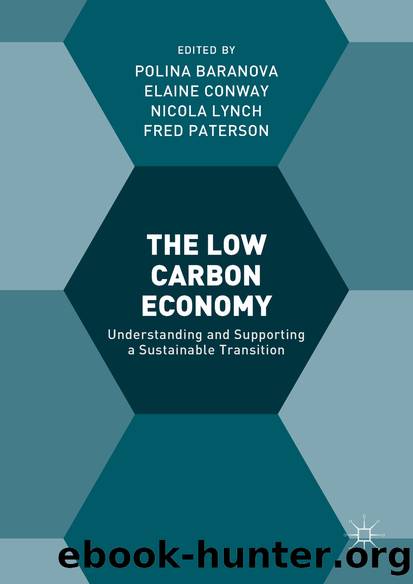The Low Carbon Economy by Polina Baranova Elaine Conway Nicola Lynch & Fred Paterson

Author:Polina Baranova, Elaine Conway, Nicola Lynch & Fred Paterson
Language: eng
Format: epub
Publisher: Springer International Publishing, Cham
5.12 Opportunities Available for SMEs to Take Advantage of the Transition to a Low-Carbon Economy
(i)Greening of Supply Chains
A large number of SMEs are part of vast supply chains and networks at regional, national and supranational levels. Development of sustainable sourcing approaches and effective carbon management across supply chains is vital. Recent studies (Gimenez and Sierra 2013, Lee and Klassen 2008, Foerstl et al. 2010) confirmed that being a part of the supply chain that encourages sustainable sourcing and conduct has a positive impact on sustainability orientation of the supply chain participants. Lee and Klassen (2008) found, in a case study of SMEs, that a combination of evaluation and collaboration provides synergies that help suppliers to build their organisational capabilities that enable them to improve their environmental performance and that of their customers (i.e., the buying firms). In a similar vein, Reuter et al. (2010) confirmed that a combination of assessment and collaboration strategies generates the greatest effect for the greening of supply chains .
Often, firms assess their individual environmental impact using the firm itself as the âsystem boundaryâ in which the assessment is made and then focusing on the physical processes within the âsystem boundaryâ/firm to reduce the impact (Berners-Lee et al. 2011; Finnveden et al. 2009; Huang et al. 2009; Pennington et al. 2004). Although this approach is valid, it might not yield significant results in carbon reduction as many carbon footprinting models consider only direct emissions (known as Scope 1) and those deriving from the purchase of energy (Scope 2). Since more than 75% of emissions in a supply chain are elsewhere in the chain, leaving out a consideration of these Scope 3 emissions can lead to a suboptimal view (Berners-Lee et al. 2011; Finnveden et al. 2009) and shift the emissions problem elsewhere in the chain (Huang et al. 2009). This is where sustainable supply chain management practices, such as joint ordering, delivery frequency optimization and batch sizing to reduce fuel consumption in delivery vehicles across the supply chain, can be helpful (Benjaafar et al. 2013). This may run counter to some of the philosophies used in lean manufacturing and just-in-time deliveries, which require small but frequent shipments which may appear to reduce the cost of inventory holding to the end manufacturer, actually add carbon to the supply chain and, therefore, indirectly increase costs in the long run (Benjaafar et al. 2013).
A system of joint shipping to common customers or ensuring that inventories are efficiently managed through the entire chain (without the need for excessive warehousing in locations close to customers) can yield significant benefits across the chain (Benjaafar et al. 2013). Green supply chain management or life-cycle analysis (LCA) rather than a firm-centric carbon footprinting exercise is a much more effective way to manage and reduce carbon systematically (Finnveden et al. 2009; Rebitzer et al. 2004; Pennington et al. 2004). This is of benefit both to the environment, but it also is better for business and ultimately profitability (Srivastava 2007; Gimenez et al. 2012).(ii)Green Innovation
Download
This site does not store any files on its server. We only index and link to content provided by other sites. Please contact the content providers to delete copyright contents if any and email us, we'll remove relevant links or contents immediately.
International Integration of the Brazilian Economy by Elias C. Grivoyannis(75125)
The Radium Girls by Kate Moore(11621)
Turbulence by E. J. Noyes(7702)
Nudge - Improving Decisions about Health, Wealth, and Happiness by Thaler Sunstein(7247)
The Black Swan by Nassim Nicholas Taleb(6771)
Rich Dad Poor Dad by Robert T. Kiyosaki(6182)
Pioneering Portfolio Management by David F. Swensen(6082)
Man-made Catastrophes and Risk Information Concealment by Dmitry Chernov & Didier Sornette(5652)
Zero to One by Peter Thiel(5494)
Secrecy World by Jake Bernstein(4389)
Millionaire: The Philanderer, Gambler, and Duelist Who Invented Modern Finance by Janet Gleeson(4101)
The Age of Surveillance Capitalism by Shoshana Zuboff(3990)
Skin in the Game by Nassim Nicholas Taleb(3971)
The Money Culture by Michael Lewis(3849)
Bullshit Jobs by David Graeber(3836)
Skin in the Game: Hidden Asymmetries in Daily Life by Nassim Nicholas Taleb(3726)
The Dhandho Investor by Mohnish Pabrai(3561)
The Wisdom of Finance by Mihir Desai(3526)
Blockchain Basics by Daniel Drescher(3331)
